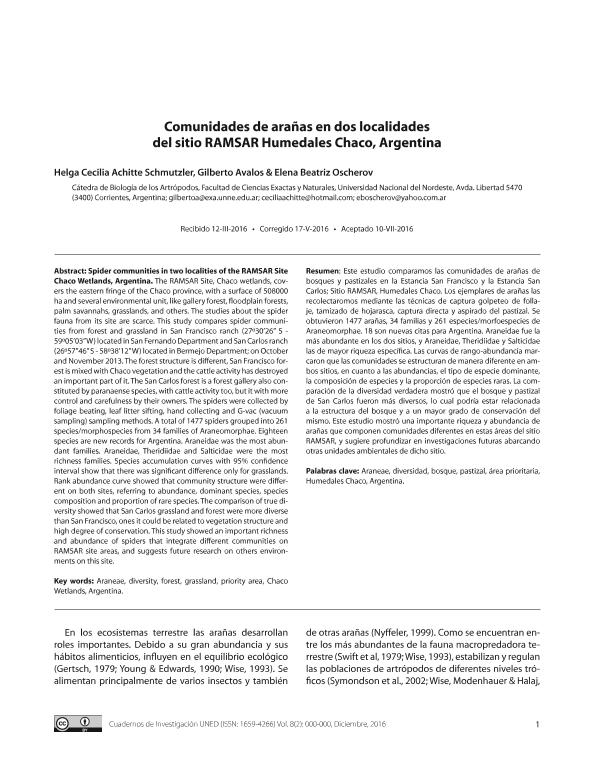Artículo
Este estudio comparamos las comunidades de arañas de bosques y pastizales en la Estancia San Francisco y la Estancia San Carlos; Sitio RAMSAR, Humedales Chaco. Los ejemplares de arañas las recolectaromos mediante las técnicas de captura golpeteo de follaje, tamizado de hojarasca, captura directa y aspirado del pastizal. Se obtuvieron 1477 arañas, 34 familias y 261 especies/morfoespecies de Araneomorphae. 18 son nuevas citas para Argentina. Araneidae fue la más abundante en los dos sitios, y Araneidae, Theridiidae y Salticidae las de mayor riqueza específica. Las curvas de rango-abundancia marcaron que las comunidades se estructuran de manera diferente en ambos sitios, en cuanto a las abundancias, el tipo de especie dominante, la composición de especies y la proporción de especies raras. La comparación de la diversidad verdadera mostró que el bosque y pastizal de San Carlos fueron más diversos, lo cual podría estar relacionada a la estructura del bosque y a un mayor grado de conservación del mismo. Este estudio mostró una importante riqueza y abundancia de arañas que componen comunidades diferentes en estas áreas del sitio RAMSAR, y sugiere profundizar en investigaciones futuras abarcando otras unidades ambientales de dicho sitio. The RAMSAR Site, Chaco wetlands, covers the eastern fringe of the Chaco province, with a surface of 508000 ha and several environmental unit, like gallery forest, floodplain forests, palm savannahs, grasslands, and others. The studies about the spider fauna from its site are scarce. This study compares spider communities from forest and grassland in San Francisco ranch (27º30’26’’ S - 59º05’03’’ W) located in San Fernando Department and San Carlos ranch (26º57’’46’’ S - 58º38’12’’ W) located in Bermejo Department; on October and November 2013. The forest structure is different, San Francisco forest is mixed with Chaco vegetation and the cattle activity has destroyed an important part of it. The San Carlos forest is a forest gallery also constituted by paranaense species, with cattle activity too, but it with more control and carefulness by their owners. The spiders were collected by foliage beating, leaf litter sifting, hand collecting and G-vac (vacuum sampling) sampling methods. A total of 1477 spiders grouped into 261 species/morphospecies from 34 families of Araneomorphae. Eighteen species are new records for Argentina. Araneidae was the most abundant families. Araneidae, Theridiidae and Salticidae were the most richness families. Species accumulation curves with 95% confidence interval show that there was significant difference only for grasslands. Rank abundance curve showed that community structure were different on both sites, referring to abundance, dominant species, species composition and proportion of rare species. The comparison of true diversity showed that San Carlos grassland and forest were more diverse than San Francisco, ones it could be related to vegetation structure and high degree of conservation. This study showed an important richness and abundance of spiders that integrate different communities on RAMSAR site areas, and suggests future research on others environments on this site.
Comunidades de arañas en dos localidades del sitio RAMSAR Humedales Chaco, Argentina
Título:
Spider communities in two localities of the RAMSAR Site Chaco Wetlands, Argentina
Fecha de publicación:
12/2016
Editorial:
Universidad Estatal a Distancia
Revista:
Cuadernos de Investigación UNED
ISSN:
1659-4266
Idioma:
Español
Tipo de recurso:
Artículo publicado
Clasificación temática:
Resumen
Palabras clave:
ARANEAE
,
DIVERSITY
,
PRIORITY AREA
,
CHACO
Archivos asociados
Licencia
Identificadores
Colecciones
Articulos(CCT - NORDESTE)
Articulos de CTRO.CIENTIFICO TECNOL.CONICET - NORDESTE
Articulos de CTRO.CIENTIFICO TECNOL.CONICET - NORDESTE
Citación
Achitte Schmutzler, Helga Cecilia; Avalos, Gilberto; Oscherov, Elena Beatriz; Comunidades de arañas en dos localidades del sitio RAMSAR Humedales Chaco, Argentina; Universidad Estatal a Distancia; Cuadernos de Investigación UNED; 8; 2; 12-2016; 115-121
Compartir
Altmétricas
Items relacionados
Mostrando titulos relacionados por título, autor y tema.
-
Achitte Schmutzler, Helga Cecilia ; Oscherov, Elena Beatriz; Avalos, Gilberto (Consejo Superior de Investigaciones Científicas, 2021-04)




